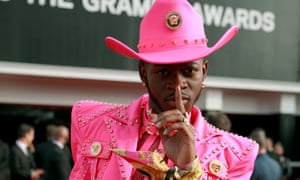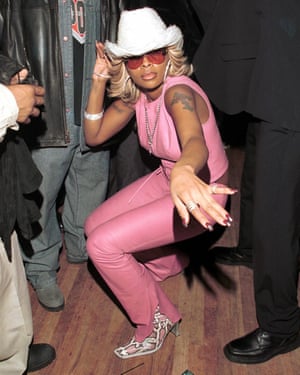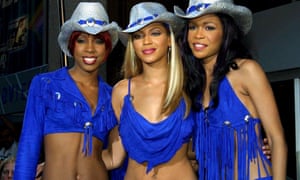From Lil Nas X to Billy Porter on the Grammys red carpet, Yee Haw fashion is everywhere. It is helping to finally put black cowboys, long erased from history, on the agenda
• Read more from the spring/summer 2020 edition of The Fashion, our biannual style supplement
Bri Malandro Fri 21 Feb 2020

Lil Nas X at the Grammy Awards in January.
Photograph: Rich Fury/Getty Images for The Recording Academy
I have been archiving the black cowboy experience online for about a year. I’ve lived in Texas for most of my life and have always been interested in the aesthetic.
I think the ubiquity of the white American cowboy myth reflects a lot of deep-rooted ideas about heteronormativity and whiteness in the US. It also speaks to the historical erasure of the black cowboy – most people don’t know that one in four cowboys were actually black.
I called the movement, and my Instagram account, which began in March 2019, “the Yee Haw Agenda” as a play on “the gay agenda”. A lot of straight people have issues with gay people or gay content being so popular and feeling as if it’s being forced on to children, which I’ve always thought was ridiculous. This has never made sense to me because the LGBTQI community has contributed so much to culture in general, stuff that they haven’t been credited for. It’s similar to the way black cowboys have not been historically credited. There are people who actually hate the term Yee Haw Agenda, but it’s funny to me because it was never meant to be as serious as it has become.
Mary J Blige in 2000.
I have been archiving the black cowboy experience online for about a year. I’ve lived in Texas for most of my life and have always been interested in the aesthetic.
I think the ubiquity of the white American cowboy myth reflects a lot of deep-rooted ideas about heteronormativity and whiteness in the US. It also speaks to the historical erasure of the black cowboy – most people don’t know that one in four cowboys were actually black.
I called the movement, and my Instagram account, which began in March 2019, “the Yee Haw Agenda” as a play on “the gay agenda”. A lot of straight people have issues with gay people or gay content being so popular and feeling as if it’s being forced on to children, which I’ve always thought was ridiculous. This has never made sense to me because the LGBTQI community has contributed so much to culture in general, stuff that they haven’t been credited for. It’s similar to the way black cowboys have not been historically credited. There are people who actually hate the term Yee Haw Agenda, but it’s funny to me because it was never meant to be as serious as it has become.

Mary J Blige in 2000.
Photograph: Steve Azzara/Corbis via Getty Images
Black erasure is something that’s happened since the beginning of time. It’s still happening today, because the chairmen, the CEOs, the company heads, the people behind the scenes and the people who are in positions to actually change things still all look the same – the same as they have always looked. So I think it’s great and important when something becomes so popular, like Yee Haw. It means people can’t ignore the disparity any more. And the people in power are forced to open the doors that have been closed for so long. These days I think social media plays a huge part in that.
Historically, the most significant Yee Haw looks have included Diana Ross’s cowgirl style for her 1969 TV special, the Gap Band’s look from the early 80s, singer Nicole Wray’s artwork for her first album in 1998 and Lil’ Kim’s look in the 1999 Get Naked music video with Tommy Lee. But the first person that comes to mind, when I think about who exudes the Yee Haw look as we know it today, is Mary J Blige. I don’t think she gets the praise for taking as many chances as she did, style wise, in the late 90s and early 00s, but she was never afraid of a good cowboy hat and boot combo. I would include Destiny’s Child in there as well. They always made being from Texas look fly, even though they got criticised for some of their earlier outfits.
Black erasure is something that’s happened since the beginning of time. It’s still happening today, because the chairmen, the CEOs, the company heads, the people behind the scenes and the people who are in positions to actually change things still all look the same – the same as they have always looked. So I think it’s great and important when something becomes so popular, like Yee Haw. It means people can’t ignore the disparity any more. And the people in power are forced to open the doors that have been closed for so long. These days I think social media plays a huge part in that.
Historically, the most significant Yee Haw looks have included Diana Ross’s cowgirl style for her 1969 TV special, the Gap Band’s look from the early 80s, singer Nicole Wray’s artwork for her first album in 1998 and Lil’ Kim’s look in the 1999 Get Naked music video with Tommy Lee. But the first person that comes to mind, when I think about who exudes the Yee Haw look as we know it today, is Mary J Blige. I don’t think she gets the praise for taking as many chances as she did, style wise, in the late 90s and early 00s, but she was never afraid of a good cowboy hat and boot combo. I would include Destiny’s Child in there as well. They always made being from Texas look fly, even though they got criticised for some of their earlier outfits.
Photograph: Sipa/REX/Shutterstock
Lil Nas X was very significant to Yee Haw: Old Town Road is literally the biggest song of all time [the song holds the record for the longest time at number one in chart history], so it goes without saying. Seeing his rise was entertaining and made perfect sense, because he’s really good at using the internet to his advantage. His stylist, Hodo Musa, is also amazing: my jaw always hits the floor when I see the looks they put together. A lot of the older people who have a problem with him now, mainly forgotten homophobic hip-hop stars, can’t keep up with his wit. He always deflects any shade thrown his way.
Recently, I saw an Out magazine headline that read The Gay Yeehaw Agenda Hit The Grammys Red Carpet, accompanied by a photo of Lil Nas X, Billy Porter and Orville Peck [all of whom wore cowboy hats to the awards ceremony]. It made me smile. The only real agenda at this point is to continue to spread the word about Yee Haw so maybe the world won’t be as shook the next time a black cowboy makes their presence known.
Diana Ross in 1979.
Lil Nas X was very significant to Yee Haw: Old Town Road is literally the biggest song of all time [the song holds the record for the longest time at number one in chart history], so it goes without saying. Seeing his rise was entertaining and made perfect sense, because he’s really good at using the internet to his advantage. His stylist, Hodo Musa, is also amazing: my jaw always hits the floor when I see the looks they put together. A lot of the older people who have a problem with him now, mainly forgotten homophobic hip-hop stars, can’t keep up with his wit. He always deflects any shade thrown his way.
Recently, I saw an Out magazine headline that read The Gay Yeehaw Agenda Hit The Grammys Red Carpet, accompanied by a photo of Lil Nas X, Billy Porter and Orville Peck [all of whom wore cowboy hats to the awards ceremony]. It made me smile. The only real agenda at this point is to continue to spread the word about Yee Haw so maybe the world won’t be as shook the next time a black cowboy makes their presence known.

Diana Ross in 1979.
Photograph: Ron Galella/Ron Galella Collection
via Getty Images
Right now, I’m just taking things a day at a time, with the growth of the account [Malandro now has 13.5k followers on Instagram]. I spoke at a festival a few months ago and got to meet some amazing people who participate in the rodeos of today. I’m working on incorporating them into the movement and helping put a spotlight on more active cowboys and cowgirls.
I don’t think the Yee Haw movement will end any time soon, because it’s more than just one moment. There may be people who lose interest, like anything that sees a spike in popularity, but fashion will always repeat itself and black cowboys will still be there, like they’ve always been.
As told to Priya Elan
Right now, I’m just taking things a day at a time, with the growth of the account [Malandro now has 13.5k followers on Instagram]. I spoke at a festival a few months ago and got to meet some amazing people who participate in the rodeos of today. I’m working on incorporating them into the movement and helping put a spotlight on more active cowboys and cowgirls.
I don’t think the Yee Haw movement will end any time soon, because it’s more than just one moment. There may be people who lose interest, like anything that sees a spike in popularity, but fashion will always repeat itself and black cowboys will still be there, like they’ve always been.
As told to Priya Elan

No comments:
Post a Comment